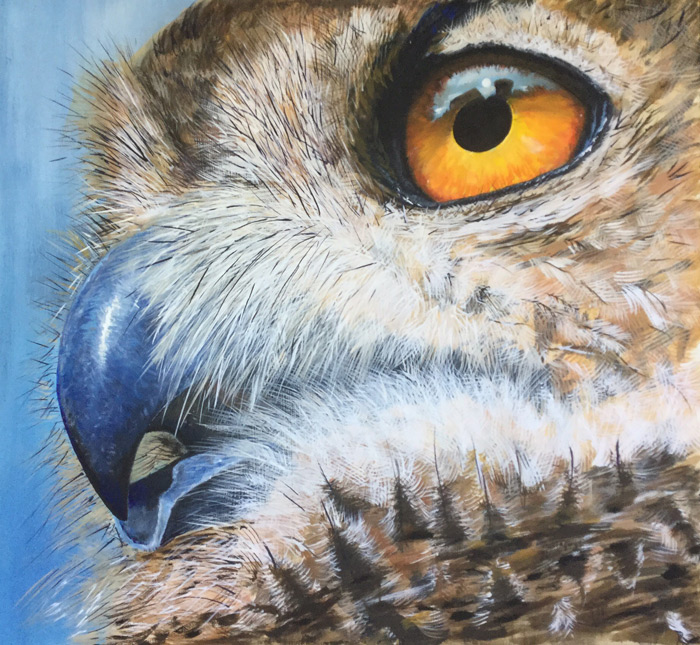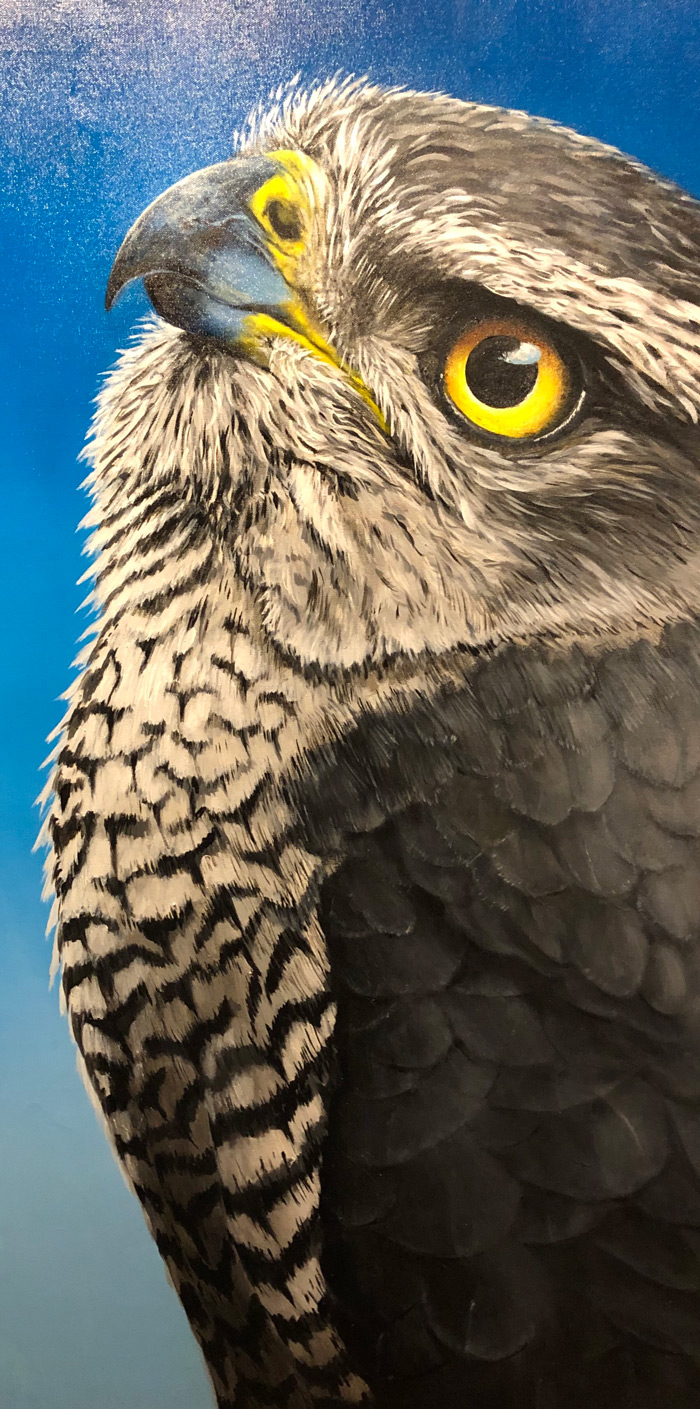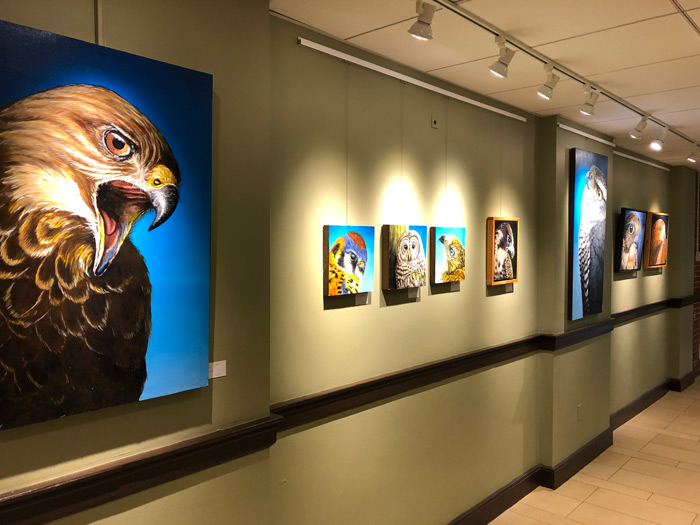With a newfound talent for painting, artist Jim Ryan draws inspiration for his expressive work from the natural world. Jim resides in the southern part of the beautiful state of New Hampshire, where there is an abundance of nature to give rise to his creativity. The focus of Jim’s art is primarily on creating unique paintings of birds of prey. As you browse through the images below, I think you’ll agree that Jim’s paintings effectively convey his love of the outdoors and evoke an emotional response in viewers.
Jim, thank you so much for taking the time to share your thoughts and views of nature through your words and paintings, as well as allowing us to get to know a bit about you. Your body of work is truly inspiring and I can’t wait to see more great things from you in the future!
If you would like to learn more about Jim, visit his website. You can also follow him on Instagram.

Can you please tell the readers a bit about yourself?
I’m 59 years old and recently moved to southern New Hampshire. I am originally from Massachusetts and still have my accent to prove it. I live with my partner (Sonja), who is also an artist, and we work out of our studio on our property.
How did you discover your passion for art?
The interesting thing is that I really just started to paint. The first time I picked up a paintbrush was only four years ago, and it was an attempt to impress Sonja, whom I was dating at the time. Because she was an artist, I took some painting lessons, but it quickly went from an attempt to impress, to a serious love affair with art. I didn’t have the time to take more lessons, but I set up a studio in my dining room and picked up a brush as often as I could.
What inspires you?
As you can see from my work, the natural world inspires me the most. I have always been an outdoor person, birding, hiking, gardening, etc. My goal with my raptor paintings is to capture the beauty and sense of awe that most miss in our busy lives running from here to there.
Are you formally taught or self-taught?
As I mentioned, I took a few lessons to get me going, but I’m mainly self-taught. I get a lot of guidance from Sonja, and it is wonderful to share a studio with her. There are also so many great resources online now through podcasts, Instagram, YouTube, etc.
What drives you to create; does it satisfy a need or passion?
Before I even picked up a brush, I was walking through a gallery in Newburyport, Massachusetts, and I imagined what it would be like to be an artist and have my own work hanging there. Soon after that, I started painting, and I developed a vision of creating a series of paintings of birds of prey. Once I had enough for a show, I then to apply to that very same gallery. Well, three years after I walked through that gallery, they selected me to be one of their solo shows. It was one of the most significant accomplishments of my life. I wasn’t sure what to expect from the show, but what I didn’t anticipate was the emotional reaction people had when viewing my work. I love creating and learning, but my real motivation is when people have to stand in front of a piece and have an emotional reaction to it.

How did you develop your style?
I guess it’s still developing. I’m still not sure how to classify my art, I guess most would call it contemporary realism. It’s exciting to see it change and develop, and I try not to force it or listen to others tell me where I should go. The artists that have influenced me include Robert Bateman, Andrew Thicshler, David Cheifetz, and John James Audubon.
What do you hope viewers take away from your work?
I want the viewers to feel what I feel when I see an owl sitting in a tree looking down at me, or when an eagle sings its song, or when a snowy owl comes in for a landing. Even if it just a little bit.
Have you ever found it difficult to part with any of your pieces?
No, by the time they are ready to be sent off into the world, I’m ready to move on to the next piece. I’m also delighted to have them hanging somewhere other than in storage.
What is your favorite piece, and why?
I would have to say the first Great Horned Owl I painted. It was the first time everything came together and moved me to a new level. I also was able to capture the rehabilitation center where it was staying. I have been connecting more with these centers to help promote and support their efforts.
What is the process you go through when creating a piece?
First, I identify photos that will work, I have to rely on good photos, and given the subject matter, they are not always easy to get. I then will do a watercolor or charcoal study. After which I determine the size I want to make it and build a canvas panel if I do not have one already made. I then outline the bird on the canvas, and from there I create the background and then underpainting. I use a layering technique and build on each layer once the layer is dry, it may take up to a month to complete one piece.
How do you know when a piece is complete?
Luckily, this has not been an issue for me. Once I feel the painting is done, I sign it and move on.
How do you go about pricing your work?
This is always a challenge. I want to make them affordable, but I also want to demonstrate their value. Size has a lot to do with it, which often does not make sense because I usually spend the same amount of time on a large piece as I do a small one. I also have to take into consideration what the gallery commission is. But, it comes down to what people are willing to spend.
Where do you currently display your art? How can people purchase one or more of your pieces?
I am not affiliated with one gallery but have been showing my work at different galleries throughout the Seacoast area (New Hampshire, Massachusetts, and Maine). The show was traveling around a lot these past two years, and I’m currently taking a bit of break and focusing on getting into some more visible galleries. You can always find me on Instagram and on my website at jimryanart.net.

What do you think the future holds for you? Where do you see yourself in the next few years?
I have been doing more still life work, and I plan to create paintings that blend still life and bird subjects. However, I also have been thinking of doing some very large paintings of raptors. The trick will be finding a place to hang them!

Leave a Reply